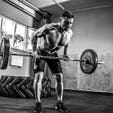Pressing straight overhead is a sure way to build strong shoulders, but not everyone can do it safely and pain-free. What can you do, then, if the classic military press hurts your shoulders, or you can’t perform it with good form? Landmine pressing is the perfect alternative to overhead pressing for training your shoulders, chest, and triceps without discomfort or injury. In addition, it makes for an athletic workout that can help you throw, push, and punch harder.
What Is The Landmine Press?
The landmine press is a type of pressing exercise that has the bar moving on an arc, rather than straight up and down. “Imagine the barbell moving like the minute hand around a clock,” says David Otey, CSCS, a trainer, author, and gym consultant (@davidoteyfit on Instagram). You load one end of the bar into a tool called a landmine unit, which is basically a metal cylinder attached to a stand—or you can wedge it into a corner of your gym—and you lift the other end like you’re throwing a lever on a machine.
This roughly 45 to 90-degree arcing motion makes the exercise a unique combination of an overhead and chest press, and it will work the deltoids, pecs, and triceps accordingly, but it’s much easier to perform than a traditional barbell overhead press.
Either due to tightness in the shoulders and upper back, or previous shoulder injuries, many people—maybe even the majority of people—cannot press a bar straight overhead safely. They’ll hyperextend their lower back, press the bar out in front of them rather than straight up, or fail to get a full range of motion at the shoulder without discomfort.
“For many people, there is no amount of foam rolling or stretching that will allow them to fully get their arm into an overhead position,” says Otey. “Their range of motion is what it is.” If this sounds like you, the landmine press is a great work-around, allowing you to train your pressing muscles heavy, and through a full range of motion, in a movement that feels more natural and safe. “With landmine pressing options, we can integrate vertical-ish patterns ranging from 45 degrees to entirely overhead, building up slowly with small increments in between,” says Otey. “No bench can replicate that much variability in range of motion.”
How To Perform The Landmine Press
(See 01:18 in the video above.)
The classic, standing landmine press should be done as follows:
Step 1. If you have a landmine unit, load one end of the barbell into the unit’s cylinder. If you don’t, it’s OK to put the bar in a corner. (You can wrap the end in a towel to protect the walls you’re using, and simply wedge it into the space.) Load the other end of the bar with weight, and stand behind the bar.
Step 2. Pick up the end of the bar and hold it at the very end, wrapping your thumb around. Hold the end of the bar about one fist’s space away from your shoulder (see the picture below). There should be roughly 30 degrees of space between your elbow and your side. Stagger your stance for balance, and brace your core, pulling your ribs down. Retract your neck so you feel like you have a double chin—it may not look sexy, but it will keep you from straining your neck.
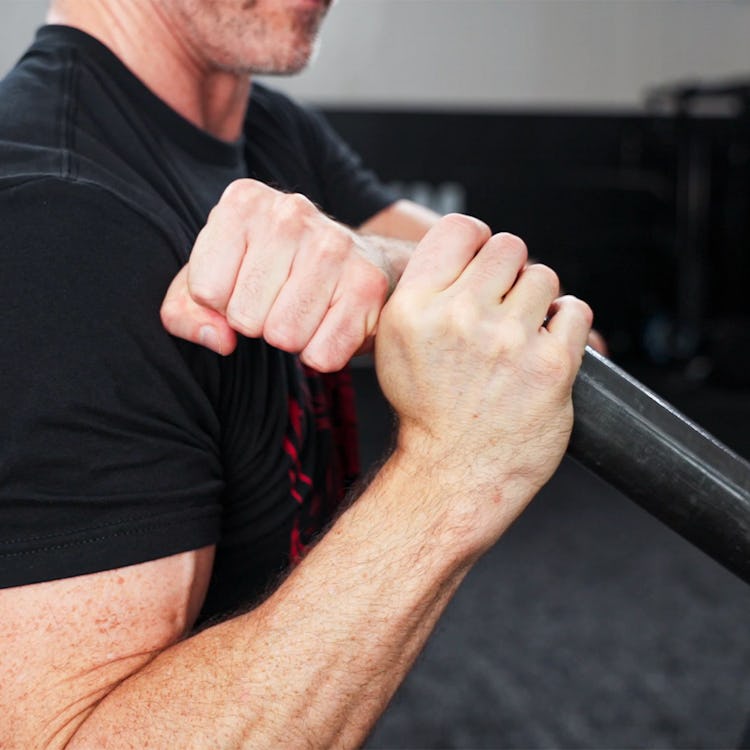
Step 3. Lean into the bar slightly for stability. You may want to extend your free arm out to the side and make a fist, which will help you keep balance. Press the bar upward to lockout, allowing your arm to move in whatever path feels natural. It may move close along your side, or in a more arcing, “around the world” motion—either is OK. As you press, your shoulder blade will rotate upward. Allow it to do this! You don’t have to lock it back and down as you might have done on a bench press. (More on this concept in a minute…)
Make sure you keep pressing at the top of the movement so that your shoulder blade moves through a full range of motion. Think, “press and reach.” You can even lean your torso forward a bit more as you press so your arm finishes straight overhead, or as high as you can comfortably go.
Hold the top position for a moment, and then lower the weight back down. Avoid letting your elbow drift behind your body in the bottom position, as that can be stressful to the shoulder. Stop where your hand is a fist space in front of your shoulder.
The Importance of Scapular Rotation in Landmine Pressing
According to Otey, the critical difference between landmine pressing and other kinds of barbell pressing is the upward rotation of the scapula—your shoulder blade—as you press the bar. Many strength coaches discourage shoulder blade movement on the bench and overhead press for the sake of greater stability to lift more weight. Whether this really contributes to stronger pressing is debatable, but locking your shoulders down can certainly lead to injury.
Otey explains that “the top side of your arm sits in a pocket called the glenoid fossa—a slight, concave structure on the outside of your shoulder blade. If you are moving your arm without moving your shoulder blade, you are inadvertently separating the joint little by little.” In other words, trying to get one body part to move independently of the other goes against the biomechanics they were designed for, and you’ll suffer the consequences with injury.
The landmine gives you the freedom to move your shoulder blade without a bench restricting it, so take advantage of the opportunity and train your shoulder to work like it’s supposed to. “Your shoulder blade should rotate upward as you press your arm up,” says Otey, “and downward as you lower the weight back.” For the record, Otey also recommends you do this on bench presses and rows to ensure proper shoulder mechanics.
What Muscles Does The Landmine Press Work?
The landmine press is arguably a full-body movement. It works all the pushing muscles in your upper body, and relies on your core and legs as stabilizers. Here’s a list of the major upper-body muscles involved, per Otey.
- Anterior deltoid (front of the shoulder)
- Lateral deltoid (side of the shoulder)
- Pec major (your main chest muscle)
- Serratus anterior (the finger-like muscles under your chest)
- Triceps brachii (the back of your arm)
- Rotator cuff (the stabilizer muscles in your shoulder joints)
- Rectus abdominis (your six-pack muscle)
- Obliques (the muscles on the side of your abs)
How To Stretch Before Exercising
Before you jump into a landmine pressing workout, warm up your shoulders, elbows, spine, and hips with this mobility routine from Onnit’s Director of Fitness Education, Shane Heins.
Landmine Press Alternatives and Variations
There are several variations of the landmine press that can be used to increase the challenge to your muscles, emphasize different muscle groups, or target different fitness goals. Otey recommends concentrating on the standing variations first until you’re comfortable pressing through a full range of motion. Then you can go on to the half-kneeling and tall-kneeling progressions.
Banded Landmine Press
(See 04:47 in the Expert’s Guide To the Landmine Press video above.)
Some trainers argue that a flaw of the landmine press is that you lose too much tension on the deltoids as you press the bar higher. Due to the arc the bar travels in, as it gets closer to vertical to the floor, the easier the exercise gets. While we think this criticism is a little overblown, you can fix the problem completely by adding a resistance band to the barbell, which will make the bar harder to lift as you get closer to locking out your elbow.
This is also a great idea if you want to train power. Fighting through the resistance of the band will force you to press it as fast as possible, and that makes you more explosive.
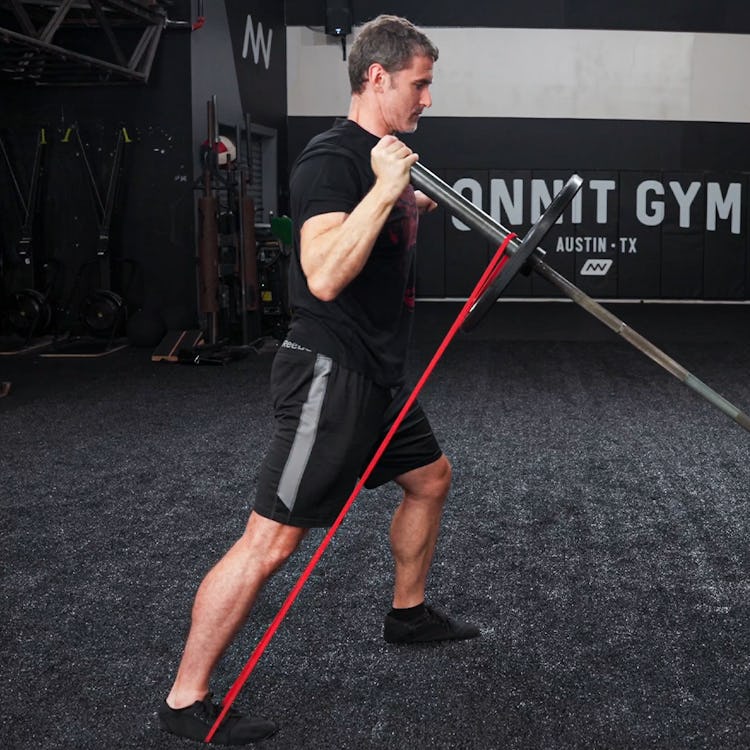
Step 1. Attach a light resistance band to the end of the barbell and stagger your feet, standing on the band with your back foot to anchor it down.
Step 2. Press the bar as hard and fast as you can, but control its descent back to your shoulder. Note that the bar may not move that fast due to the resistance, but you should still try to move it as fast as you can.
Rotational Landmine Press
(See 06:08 in the Expert’s Guide To the Landmine Press video above.)
Another great way to build athleticism with the landmine press is to do it as a rotational press, where you switch hands and twist your torso as you press, which mimics the action of throwing a ball or a punch.
Note that because this is an explosive movement, it might cause the opposite end of the bar (the one you’re NOT holding) to “jump” up and out of position if you’ve got it wedged into a wall rather than a landmine. So if you don’t have a landmine unit to provide stability, you might want to skip this one until you do.
Step 1. Load the bar with very light weight and stand perpendicular to it with a wide stance. If your left side is closest to the bar, pick it up with your left hand on the bar itself—not the sleeve where you load plates, as you’ve done up till now—and let your arm hang in front of your body as you get into an athletic stance.
Step 2. Extend your hips and knees explosively, shrugging the bar up in front of your body until it reaches the height of your lower ribs. At the same time, pivot your back foot to face the landmine and pass the bar to your right hand, grasping it at the end of the sleeve. Allow the momentum of your twisting torso to help you press the bar up as hard and fast as possible.
Reverse the movement on the way back down, so that the bar ends up in your left hand again.
Half-Kneeling Landmine Press
(See 03:00 in the Expert’s Guide To the Landmine Press video above.)
The half-kneeling landmine press is a progression you can move to after you’ve mastered the standing landmine press. “The standing press tends to be easier,” says Otey, “because the weight is slightly higher off the ground, and you gain stability by leaning into the bar. As you descend to lower positions, such as half-kneeling, it gets more challenging because the bar path is more vertical.” Kneeling on the floor is also a more unstable position than standing and really requires you to lock in your core and use strict form, but all the same technique cues still apply.
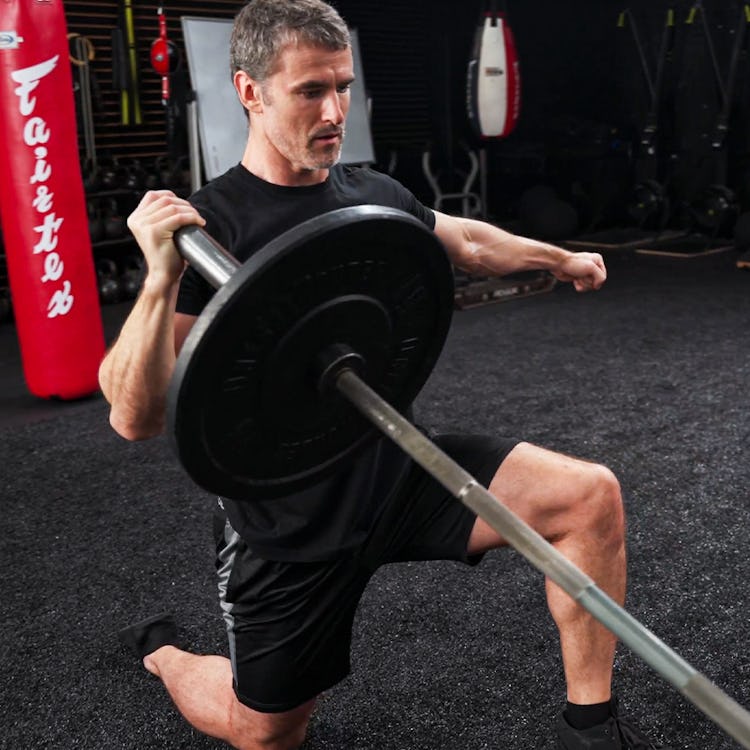
Step 1. Kneel on the floor with your right knee down and directly under your hips. Your left knee should be bent 90 degrees, and your stance about shoulder width. Tuck your tailbone under so your pelvis is level with the floor, and make sure you’re not kicking one hip out to the side. Pick up the bar and hold it at the end, about a fist’s space from your shoulder. Drive the downed knee into the floor so you feel your glute contract and help brace you.
Step 2. Press the bar up as high as you can while maintaining control, leaning forward at the top and reaching your arm up the best you can. Hold the top position for a moment.
Be careful you don’t twist toward the front knee while you’re pressing, or extend your lower back. Keep your ribs pulled down—imagine they’re connected to the front of your hips.
Tall-Kneeling Landmine Press
(See 04:00 in the Expert’s Guide To the Landmine Press video above.)
Pressing with both knees parallel to each other makes for a very unstable, and therefore very challenging press that also works the glutes pretty hard. You can’t use any momentum on this one, so it’s the next level up from the half-kneeling press, although it will probably require you to use lighter weight.
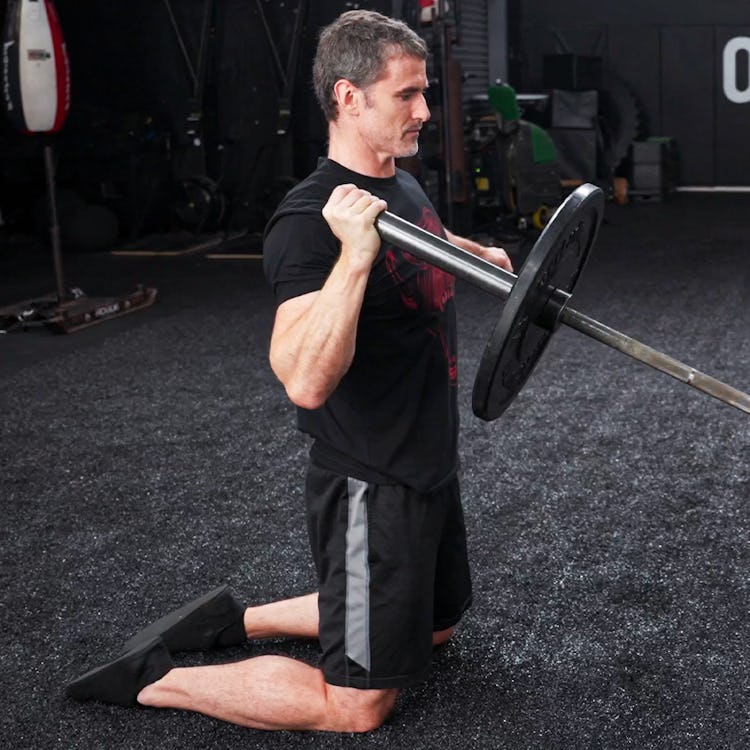
Step 1. Kneel on the floor behind the bar so your knees are directly under your hips. You can point your toes into the floor or rest them flat—whichever feels more comfortable and stable to you. Pick up the end of the bar and hold it one fist’s space in front of your shoulder. Tuck your tailbone so your pelvis is parallel to the floor and brace your abs. You should be very tall, with a straight line from your head to your pelvis.
Step 2. Press the bar overhead, holding the top position for a moment.
Floor Press
(See 07:02 in the Expert’s Guide To the Landmine Press video above.)
The landmine doesn’t just make overhead pressing feel better on your shoulders—it can do the same thing for bench press variations. Try lying on the floor and doing a floor press with the landmine. The shortened range of motion is easy on the shoulder, and you’ll put more emphasis on your triceps to lift the weight, making it a good arm-building move.

Step 1. Lie on the floor with your head about even with the plate on the barbell. Bend your knees and rest your feet on the floor. Grasp the bar at the end of the sleeve with both hands to lift the bar into position over your chest. Flatten your back into the floor, and brace your core.
Step 2. Lower the bar with one hand until your triceps touch the floor—don’t let your arm crash down on your elbow. Pause a moment, and then press the bar up.
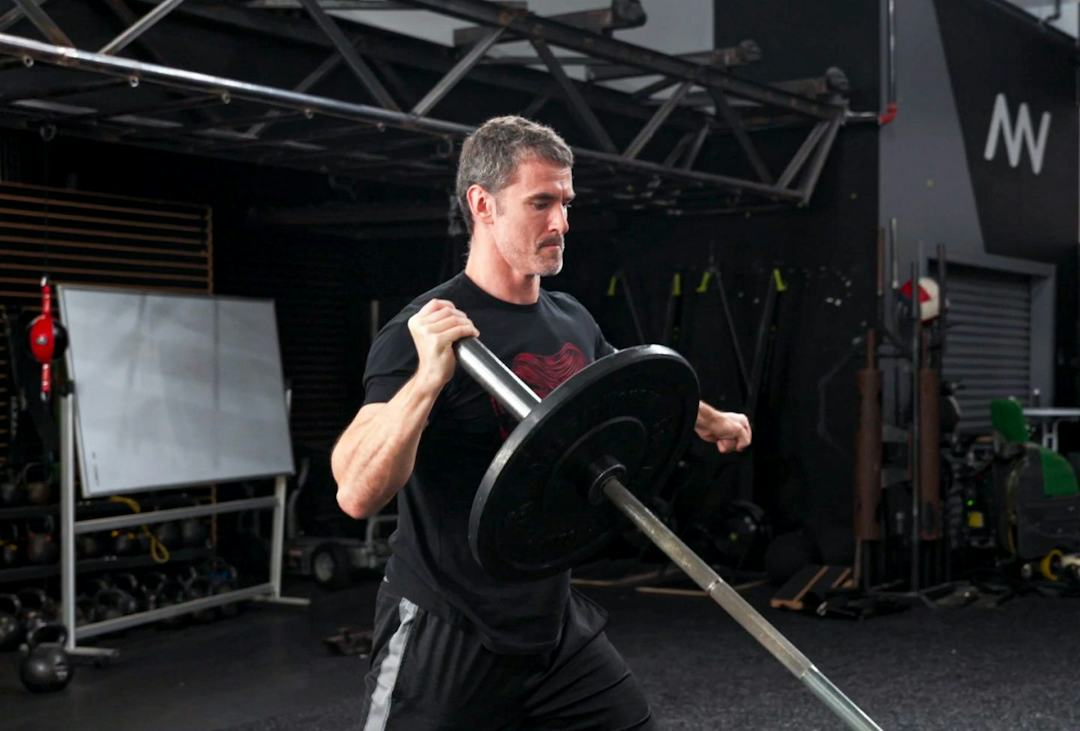
)

